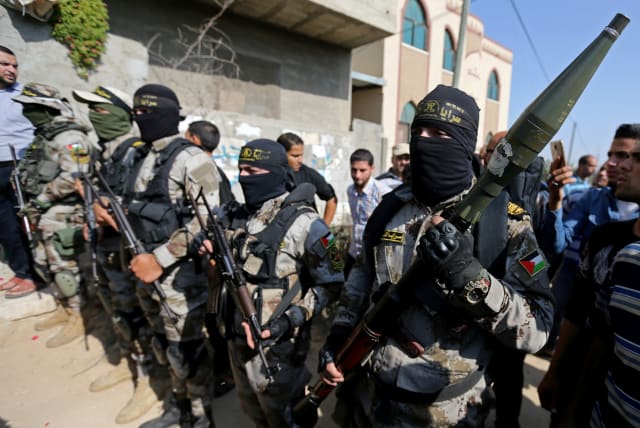Brothers-in-arms? Hamas spies on Islamic Jihad, IDF reveals in document

IDF Spokesperson reveals Hamas classified document spying on the propaganda operations of the Iran-backed militia, fearing credit stealing and self-aggrandization.
A recently unveiled document originating from the Qassam Brigades’ military intelligence division exposes Hamas’s surveillance activities targeting Palestinian Islamic Jihad, highlighting Hamas’s concerns that the PIJ may criticize Hamas or take credit for “resistance operations.”
Discovered amid the IDF’s ground operations in Gaza, and dating back to December 2022, the document outlines the leadership’s grievances with the media narratives produced by the Palestinian Islamic Jihad organization, also officially acknowledging the self-damaging rocket launches it conducted during Operation Breaking Dawn in August 2022.
Highlighted within the document are three distinct media initiatives taken by the PIJ’s propaganda wing, intended to highlight the organization’s autonomous terrorist operations and glorify them. These include a TV series regarding the PIJ’s “resistance operations,” including suicide bombers, between 2000-2005; a documentary about the group’s al-Quds Brigades’ drone array; and an episode regarding al-Quds Brigades on a popular TV show on Al Jazeera.
#عاجل حماس ضد الجهاد الإسلامي: وثيقة صادرة عن الاستخبارات العسكرية لكتائب القسام تكشف عن تجسس حماس على منظمة الجهاد الإسلامي الإرهابية وعملها على التأثير على المضامين الدعائية الصادرة عنها ⭕️ حماس تعترف في الوثيقة بشكل رسمي بعمليات الإطلاق الفاشلة للقذائف الصاروخية من قبل… pic.twitter.com/9zrzk7BfKs
— افيخاي ادرعي (@AvichayAdraee) March 5, 2024
In this context, the document also lists the collaboration of different media outlets with the PIJ as part of its propaganda strategy. In addition to Al Jazeera and its Palestinian anchor Tamer Almisshal, it also lists channels identified by Hamas as “belonging to the ‘Axis of Resistance’”: Al-Manar, Al-Mayadeen, and Al-Masirah; and identifies two major Palestinian channels as “channels belonging to the PIJ”: Al-Quds Al-Youm, and Filastin Al-Youm.
يتحدثون عن غرفة عمليات مشتركة للفصائل، وينشرون الأفلام الدعائية المشتركة، ويحاولون التظاهر بمظهر وحدة المنظمات، بيد أنه وراء الكواليس تتجسس حماس على الجهاد الإسلامي وتعمل على التأكد من عدم رفعه لرأسه، وتعترف بكذبها السافر حينما ساعدت المنظمة على إشاعة الأكاذيب بشأن عمليات إطلاق… pic.twitter.com/ZeApepLaam
— افيخاي ادرعي (@AvichayAdraee) March 5, 2024
The recommendations
The Hamas document then moves on to present four recommendations to the terror group’s leadership vis-à-vis this strategy. One of these suggestions involves turning to the PIJ leadership to make sure that there would be no direct or implied criticism of Hamas, and that the “national dimension” is given priority over the factional one.
The second proposition is that Hamas leadership reaches out to Al Jazeera anchor Almisshal and make sure that his program “doesn’t exaggerate the ballistic capabilities” of the PIJ, especially as “some of the [missiles] fell down on [Gazan] citizens in August;” as well as avoiding a narrative that depicts the PIJ as the ones who sent the first blow to Tel Aviv.
Thirdly, the Hamas document suggests instructing Hamas members not to criticize the PIJ in a manner that may be understood as disapproving “the growth of the resistance,” but rather to create an inclusive atmosphere to the “resistance actions” in Gaza.
Finally, the last recommendation presented by the Hamas intelligence division called to reach out to the producer of the program on Al-Mayadeen and Al-Manar and attempt to “influence its content” to make sure that it includes shared operations by Hamas and PIJ militias in order to “strengthen relations” between the groups.
يتحدثون عن غرفة عمليات مشتركة للفصائل، وينشرون الأفلام الدعائية المشتركة، ويحاولون التظاهر بمظهر وحدة المنظمات، بيد أنه وراء الكواليس تتجسس حماس على الجهاد الإسلامي وتعمل على التأكد من عدم رفعه لرأسه، وتعترف بكذبها السافر حينما ساعدت المنظمة على إشاعة الأكاذيب بشأن عمليات إطلاق… pic.twitter.com/ZeApepLaam
— افيخاي ادرعي (@AvichayAdraee) March 5, 2024
Hamas and PIJ: two Iranian-backed Palestinian factions competing for glory
BOTH HAMAS and the PIJ are recognized mainly in the Gaza Strip, though both of them enjoy popularity and presence in the West Bank as well. Additionally, both enjoy material and moral support of Iran and its proxies.However, while Hamas is also committed to its values and principles of what became to be known as “political Islam” rooted in its parent organization, the Muslim Brotherhood, the founders of Palestinian Islamic Jihad were fascinated by the Khomeinian revolution in Iran, and thus are more loyal to the Islamic Republic and its self-described “Axis of Resistance” encompassing Iran, Hezbollah, the Syrian regime, the Houthi movement, and other militias across the Middle East.Another difference lies in the fact that Hamas is more embedded with Palestinian society and enjoys a wider popular backing, as well as acting as a semi-state governmental actor responsible for infrastructure, education, and other needs; while the PIJ is more of a free roaming group, even less committed to the local population than its rival Hamas.Lately, the two organizations have attempted to project an alleged unity to the outside world, sometimes by co-producing video clips simulating shared operations during the current war.However, a glimpse into the real state of affairs between these two rival factions can be identified in this document, which showcases Hamas’s fears from credit stealing or aggrandization of the PIJ and its capabilities.Another example for the schism between the groups could be witnessed during Operation Breaking Dawn, when Hamas avoided entering a confrontation with Israel while the latter was targeting the PIJ’s capabilities and terrorists, much to the PIJ’s dissatisfaction.Avichai Adraee, IDF spokesperson for Arab media, said discussions about a combined operations room and the release of shared propaganda videos attempt to create an illusion of solidarity among the factions.“However, beneath the surface, Hamas closely monitors Islamic Jihad, preventing it from becoming too prominent, while acknowledging the fabricated narratives about its rocket failures that have led to a high toll on Gazan civilians,” he said.
Jerusalem Post Store
`; document.getElementById("linkPremium").innerHTML = cont; var divWithLink = document.getElementById("premium-link"); if (divWithLink !== null && divWithLink !== 'undefined') { divWithLink.style.border = "solid 1px #cb0f3e"; divWithLink.style.textAlign = "center"; divWithLink.style.marginBottom = "15px"; divWithLink.style.marginTop = "15px"; divWithLink.style.width = "100%"; divWithLink.style.backgroundColor = "#122952"; divWithLink.style.color = "#ffffff"; divWithLink.style.lineHeight = "1.5"; } } (function (v, i) { });
